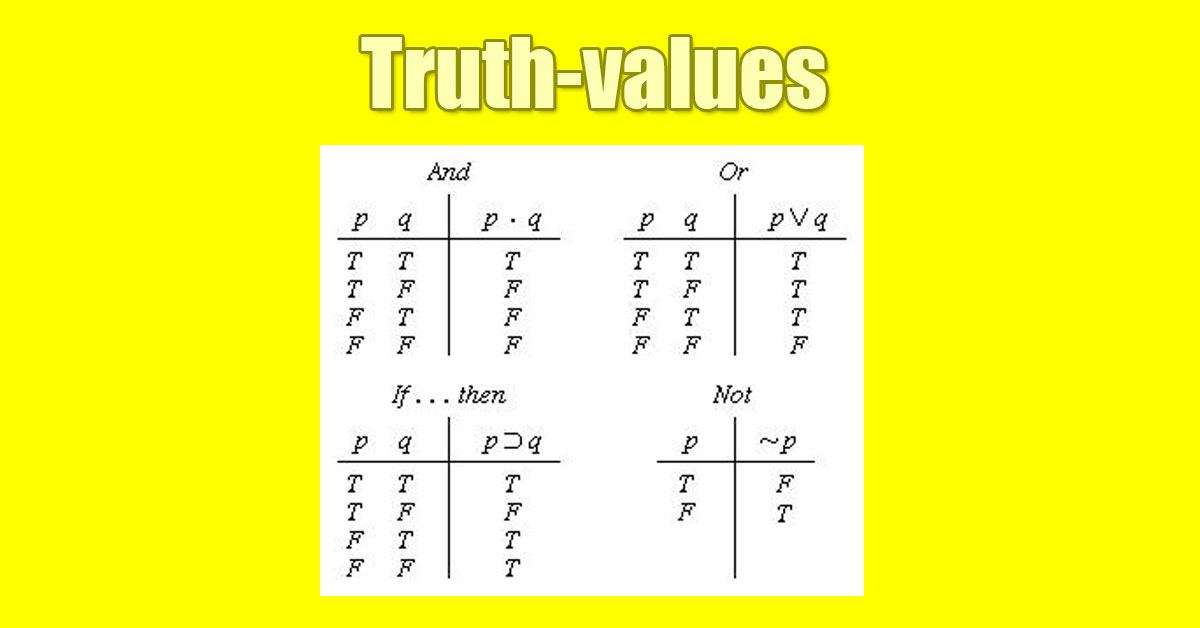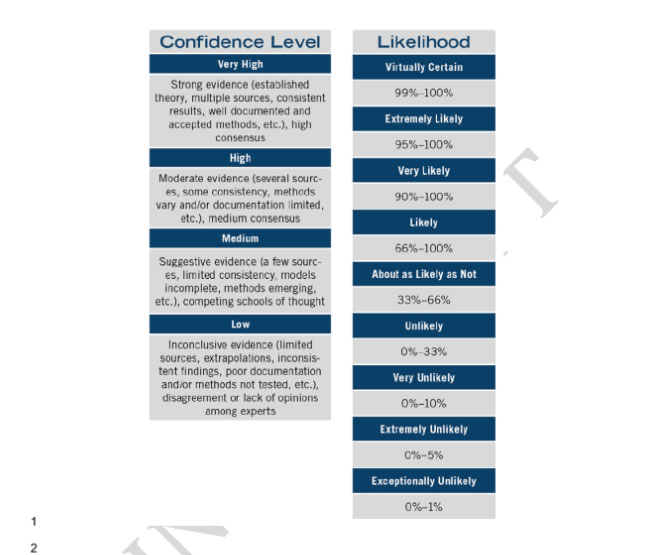What is a Truth-Value?

Understanding Truth-Values
A truth-value is a label that is given to a statement (a proposition) that denotes the relation of the statement to truth.[1][2]
In general, all statements, when worded properly, are either true or false (even if we don’t know with certainty their truth-value, they are ultimately true or false despite our ability to know for sure).
With that said, and as noted, humans can’t know every truth for certain, and thus there are some “unknowns.”
Thus, all truth-values can be transposed to a three-value form: True, False, and Unknown (where unknown denotes our lack of knowledge, not a lack of truth).
Further, because there are things humans can’t know for sure, we have to express the likelihood of some truths using multiple-value truth-values. For example: very likely false, likely false, likely true, very likely false. Or, such is the case where the quality of a complex statement or argument is being considered, False, Mostly False, Half True, Mostly True, and True.
Additionally, because some statements have a variable truth-value that changes depending on context or on more information like “the cat is on the mat” (which is only true when the cat is on the mat, otherwise it is the case that it is false) and x+1=1 (which is only true when for example x=0) we also have to consider “variable” or “conditional” truth-values (propositions that have truth-values that are not constant and instead depend on more information, but otherwise adhere to the other rules stated).
Consider the following statements:
- 1+1=2 is true. It is deductive (it is logically certain that the conclusion =2 follows from the premise 1+1).
- 1+x=2 is conditional; it is true if x=1 but, not true otherwise.
- The statements 1+1=2 and 1+2=4 considered as a single argument is “half-true.”
- 1+x=2, where x=1 90% of the time and x=0 10% of the time according to tests, is probably true in a single instance (there is a 90% chance the statement will be true in each instance). It is inductive (the conclusion =2 doesn’t necessarily follow from the premise 1+x).
TIP: The image below is an example of how we can state confidence and likelihood for inductive inferences (conclusions to arguments made using inductive evidence). The idea is to use “multi-value” truth-values to communicate to a reader how likely a truth is and how confident the author is of the findings. If confidence and likelihood are stated, then a statement which contains probable truth can itself be considered true.

When we consider inductive evidence we have to state confidence as multi-value truth values. Example from 2017 Climate Change report.
On compound statements and truth-values: A well phrased proposition (a theory under inspection or on our site “a factoid“) generally consists of two concepts connected by a qualifier (in its most basic form at least). All statements of this type, when phrased correctly and not “unknown,” can be given a two-value truth-value of True or False where True means certainly true or very likely true, and False means certainly false or very likely false (depending on the context). The statement “all bachelors are unmarried” is necessarily and certainly true, the statement “the mass is equivalent to the energy in a closed system” is very likely true and is true to the best of our knowledge despite the inherent uncertainty of the material universe. Both those statements are “facts,” but one is tautological and the other one scientific. Then, when multiple compound propositions are strung together it forms an argument, with arguments some statements could be have certain truth-values, and other probable ones, some could be necessarily true, and some could be false, and some could be unknown. In complex arguments, or with nuanced propositions, it can be useful to use truth-values like “mostly true” and “mostly false” (and other truth-values that state certainty in different forms).
A Summary of the Basic Types of Truth Values
- In classical two-value logic, truth-values are binary distinctions like: 1 or 0, A or B, Yes or No, True or False. They are certain truth-values that states whether a proposition is true or false.[3]
- Closely related is another type of truth-value rooted in classical logic (in induction specifically), that of multi-valued logic and its “multi-value truth-values.”
- Multi-valued logic can be used to present a range of truth-values (degrees of truth) such as the ranking of the likelihood of a truth on a scale of 0 to 100%.
- A probable truth-value can be presented as a range of choices (very likely false, likely false, likely true, very likely true), or can be transposed to a binary choice of “likely true” or “likely false”).
- We can also play with phrasing to qualify statements and arguments. For example, half-true arguments can be given a binary or multi-value truth-value such as “mostly false,” “half-true,” or “mostly true.”
- One should also consider that we know there are known unknowns (there are statements that are true or false, but that we don’t know are true or false for certain). So it helps to recognize 3-value logic: True, False, and Unknown (expressed as such, or expressed as degrees of truth using multi-value truth-values).
The General Idea Behind Truth-Values and the Nature of Probability, Unknowns, and Induction
In all cases, the term “truth-value” is used in formal logic to denote the validity / soundness / strength / cogency of a proposition or argument where in deductive propositions and arguments certain truth-values can be assigned, and in inductive arguments where probable truth-values (and thus degrees of truth) are assigned (learn more about the terms of logic, reason, and the argument forms, and learn more about truth in general).
Despite the probable nature of induction (which compares probable statements), when things are “very highly certain” they can be considered true and proven until better data comes along (this is the theory behind scientific theories).
Thus, we can say it is true that mass and energy are equivalent, or true that F=ma (these “factoids” have been shown to be true 100% of the time when put to scientific test; so they are scientific truths, a scientific theory, with truth-values that are “very likely” the case given the evidence).
Here we can note that:
- The Principle of bivalence says, “every declarative sentence expressing a proposition (of a theory under inspection) has exactly one truth-value, either true or false.” In other words, every statement structured properly has a definite binary truth-value (two-value True or False logic).[4]
- Yet, constructivism (in the philosophy of mathematics) shows us that, even though everything is either true or false, there are some things we don’t know. So we have to consider 3-value logic: True, False, and Unknown.
- Thus, we often have to consider probability and unknowns despite our ability to assign two-value truth-values to any properly worded statement.
With the above in mind, some propositions (statements) can be phrased in a way that they won’t have a certain truth-value (such is the case with true paradoxes and nonsense statements), however and in general, any idea can be stated as a single proposition or series of propositions with certain or very highly likely truth-values (with either very likely true or false or certainly true or false).
When a statement is very likely true or certainly true, it is considered true, and when it is very likely false or certainly false it is considered false.
On our site, when you see the term “fact” it means certainly a fact or highly likely a fact (and this will become clear form the supporting argument), likewise when you see the term “myth” it means certainly false or highly likely false (and this will become clear form the supporting argument as well).
If a factoid is “unknown” we don’t try to give it a certain truth-value, instead we will restructure the “theory under inspection” (the factoid) until it is in a form that can be given a certain binary two-value truth-value.
With all that said, ultimately, and despite our fumbling in the dark as fallible humans, everything is either true or it isn’t, this is true despite our ability to prove all things true or false with certainty… and that is good to know, because the reality of our world is that we can’t know much of anything for certain (after-all our senses may be tricking us, perhaps we are in a simulation, maybe in another universe of the 10th dimension up is down, etc).
Truth Tables
Understanding truth-values is step one, step two is understanding truth tables (tables that show how truth-values relate using different reasoning types). I’ll do a page on that soon, for now here is an example:
The truth table associated with if…then reasoning where the truth table for the “material conditional” p→q (if p therefore q) is as follows:[5]
 |
 |
 |
|---|---|---|
| T | T | T |
| T | F | F |
| F | T | T |
| F | F | T |
TIP: The first row above means if p is true, and q is true, then the statement “if p then q” is true (or we can say p implies q). For propositions we can say, if proposition p is true, and conclusion q is true, then it is true that p implies q.
Learn more about truth tables here.

Raymond K. Ernewein
Thank You for this FACT/MYTH site. I have not found any thing that did not belong. It would be very interesting if Human traits could be considered in a more usable form like the DISC model.
Thomas DeMicheleThe Author
Thanks for the kind words. That is an interesting idea, I love models like that. They are very helpful for better understanding the human condition.